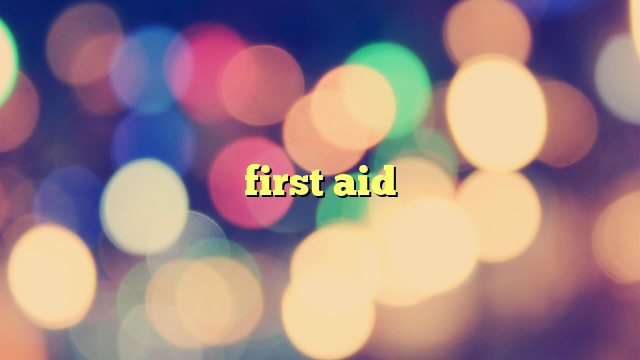When should you call for emergency medical help?
“`html
Essential First Aid: Your Comprehensive Guide to Safety and Care
In emergencies, knowing how to administer first aid can save lives. Whether you’re at home, work, or out in public, having basic first aid knowledge equips you to respond effectively to injuries and medical situations. This comprehensive guide will cover key first aid techniques, their benefits, practical tips, and real-life case studies, ensuring you’re prepared for any situation.
What is First Aid?
First aid is the initial assistance provided to someone suffering from an injury or illness until professional medical help arrives. It involves a set of basic techniques designed to stabilize the patient’s condition and prevent further harm. Key first aid skills include:
- CPR (Cardiopulmonary Resuscitation)
- Using an AED (Automated External Defibrillator)
- Controlling bleeding
- Managing burns
- Treating fractures and sprains
The Importance of First Aid
Understanding first aid is crucial for several reasons:
- Life-Saving Skills: Quick and effective first aid can make the difference between life and death.
- Recognizing Emergencies: Knowing how to assess a situation helps in determining the right course of action.
- Reducing Recovery Time: Proper first aid can minimize the severity of injuries, leading to quicker recovery.
- Building Confidence: Being trained in first aid increases your confidence to act in emergencies.
Essential First Aid Techniques
1. Cardiopulmonary Resuscitation (CPR)
CPR is a lifesaving technique used in emergencies when someone’s breathing or heartbeat has stopped. Here’s a step-by-step guide:
- Check Responsiveness: Tap the person and shout to see if they respond.
- Call for Help: Dial emergency services or ask someone else to do so.
- Open Airway: Tilt the head back slightly and lift the chin.
- Check Breathing: Look, listen, and feel for normal breathing.
- Start Chest Compressions: Place your hands on the center of the chest and push hard and fast (100-120 compressions per minute).
- Give Rescue Breaths: After every 30 compressions, give 2 rescue breaths.
2. Controlling Bleeding
When someone is bleeding, take these steps:
- Apply Pressure: Use a clean cloth or bandage to apply direct pressure to the wound.
- Elevate the Injury: If possible, raise the injured area above the heart level.
- Seek Medical Help: If bleeding does not stop after 10 minutes, seek professional help.
3. Managing Burns
For minor burns:
- Cool the burn under running water for at least 10 minutes.
- Cover the area with a sterile, non-stick bandage.
- Avoid applying ice or butter, as these can worsen the burn.
Benefits of First Aid Training
Investing time in first aid training offers numerous benefits:
- Preparedness: You’ll be ready to handle emergencies at home, work, or in public.
- Team Safety: In workplaces, trained employees create a safer environment for everyone.
- Community Impact: First aid training can foster a community of preparedness and response.
Practical Tips for First Aid
Here are some useful tips for effective first aid:
- Keep a first aid kit accessible and well-stocked.
- Regularly check expiration dates on supplies.
- Familiarize yourself with the contents of your first aid kit.
- Stay calm and act quickly during emergencies.
Case Studies: Real-Life First Aid Experiences
1. The Saving of a Life at the Park
A mother was at the park with her children when one of them fell from the swing and hit his head. He was unconscious, and she quickly performed CPR while a bystander called for help. Thanks to her quick actions, the boy regained consciousness before the ambulance arrived.
2. Controlling Severe Bleeding After an Accident
A man witnessed a motorcycle accident where the rider had a severe leg injury. He immediately applied pressure to the wound and elevated the leg. His quick thinking and knowledge of first aid helped control the bleeding until paramedics arrived.
First Aid Experience: A Personal Story
During a family camping trip, my younger brother accidentally cut his hand while preparing food. Thankfully, I had taken a first aid course and knew how to clean the wound properly, apply pressure to stop the bleeding, and cover it with a sterile bandage. This experience solidified the importance of first aid knowledge and preparation.
Conclusion
Understanding first aid is not just beneficial; it’s essential. Whether through formal training or self-study, equipping yourself with first aid knowledge and skills can dramatically change the outcome of emergencies. Remember to stay calm, act decisively, and always seek professional medical help when necessary. Your ability to provide first aid can make all the difference and save lives.
First Aid Resources
For further learning and resources, consider the following:
| Resource | Type | Link |
|---|---|---|
| American Red Cross | Training & Certification | Visit Site |
| St. John Ambulance | First Aid Courses | Visit Site |
| Health and Safety Executive | Guidelines | Visit Site |
Don’t wait for an emergency to learn these vital skills. Take the initiative and begin your first aid training today!
“`
